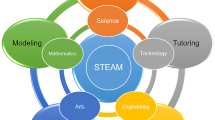Abstract
In the early stages of learning, children engage with mathematics concepts through play, their environment and social interactions. Children are naturally curious and investigate their world through exploration, questioning and wondering. Informal everyday experiences incorporate opportunities for mathematical thinking and the context for deeper understanding. It is meaningful opportunities and hands-on experiences that stimulate inquiry. Using existing knowledge, play and intentional teaching can support deeper thinking and more abstract concepts. Problem-solving is embedded in mathematical thinking, and as children navigate their world, they are discovering and exploring using trial and error. Using an inquiry-based learning approach, purposeful investigations can be explored in realistic contexts to embed mathematics and other STEAM disciplines.
Access this chapter
Tax calculation will be finalised at checkout
Purchases are for personal use only
Similar content being viewed by others
References
Bruner, J. S. (1966). Toward a theory of instruction. Cambridge, MA: Harvard University Press.
Bybee, R. W. (2013). The case for STEM education: challenges and opportunities. Arlington, VA: NSTA Press.
Bybee, R. W. (2014). The BSCS 5E instructional model: Personal reflections and contemporary implications. Science and Children, Apr.–May. http://go.galegroup.com/ps/i.do?id=GALE%7CA377575190&v=2.1&u=cowan&it=r&p=AONE&sw=w&asid=4c7b596fb31108ad66a2200428b98476
Department of Education and Children’s Services South Australia. (2008). Assessing for learning and development in the early years using observation scales: Reflect, respect, relate. Hindmarsh, Australia: DECS Publishing.
Department of Education, Employment and Workplace Relations (DEEWR). (2009). Belonging, being and becoming: The early years learning framework for Australia. Canberra, ACT: Commonwealth of Australia.
Dewey, J. (1938). Experience and education. Springfield, OH: Collier Books.
Dugger, W. E., Jr. (2010). Evolution of STEM in the United States. Sixth Biennial International Conference on Technology Education Research.
González, N., Moll, L. C., & Amanti, C. (Eds.). (2005). Funds of knowledge: Theorizing practices in households, communities and classrooms. Mahwah, NJ: Lawrence Erlbaum.
Hedges, H., & Cooper, M. (2014). Inquiring minds, meaningful responses: children’s interests, inquiries, and working theories. Wellington, New Zealand: TLRI.
Irons, R. (2007). Mathematics for young minds: Beginning processes. Brendale, Australia: Origo Education.
Knaus, M. (2013). Maths is all around you: Developing mathematical concepts in the early years. Albert Park, Australia: Teaching Solutions.
Knaus, M. (2017). Supporting early mathematics learning in early childhood settings. Australasian Journal of Early Childhood, 42(3), 4–13.
Krogh, S., & Morehouse, P. (2014). The early childhood curriculum: Inquiry learning through integration (2nd ed.). New York/London: Routledge.
MacDonald, A. (2015). Investigating mathematics, science and technology in early childhood. Oxford, UK: Oxford University Press.
Moomaw, S. (2013). Teaching STEM the early years: activities for integrating science, technology, engineering, and mathematics. St. Paul, MN: Redleaf Press.
Moomaw, S., & Davis, J. (2010). STEM comes to preschool. Young Children, 65(5), 12–18.
Murdoch, K. (2015). The power of inquiry: Teaching and learning with curiosity, creativity and purpose in the contemporary classroom. Northcote, Australia: Seastar Education.
Murdoch, K. (2019). Updated diagram – Designing a journey of inquiry 2019. https://www.kathmurdoch.com.au/
National Council of Supervisors of Mathematics and the National Council of Teachers of Mathematics. (n.d.). Building STEM education on a sound mathematical foundation: A joint position statement on STEM from the national council of supervisors of mathematics and the national council of teachers mathematics. https://www.nctm.org/uploadedFiles/Standards_and_Positions/Position_Statements/Building%20STEM%20Education%20on%20a%20Sound%20Mathematical%20Foundation%20(NCSM-NCTM%202018).pdf
Organisation for Economic Co-operation Development (OECD). (2012). The nature of learning: Using research to inspire practice: Practitioner guide from the innovative learning environments project. Paris: OECD Publications.
Pedaste, M., Maeots, M., Siiman, L. A., de Jong, T., van Riesen, S. A. N., Kamp, E. T., et al. (2015). Phases of inquiry-based learning: Definitions and the inquiry cycle. Educational Research Review, 14, 47–61.
Pelesko, J. A. (2015). STEM musings. Model with mathematics website: http://modelwithmathematics.com/2015/11/stem-musings/
Perry, B., Gervasoni, A., & Dockett, S. (2012). Let’s count: Evaluation of a pilot early mathematics program in low socioeconomic locations in Australia. In J. Dindyal, L. P. Cheng, & S. F. Ng (Eds.), Mathematics education: Expanding horizons (Proceedings of the 35th annual conference of the Mathematics Education Research Group of Australasia) (Vol. 2, pp. 594–601). Adelaide, Australia: Mathematics Education Research Group of Australasia.
Piaget, J. (1952). The origins of intelligence in children (8, 5, pp. 18–1952). New York: International Universities Press.
Riccomini, P. J., Smith, G. W., Hughes, E., & Fries, K. M. (2015). The language of mathematics: The importance of teaching and learning mathematical vocabulary. Reading & Writing Quarterly, 31(3), 235–252. https://doi.org/10.1080/10573569.2015.1030995
Rosales, A. (2015). Mathematizing: An emergent math curriculum approach for young children. St. Paul, MN: Redleaf Press.
Rosicka, C. (2016). From concept to classroom: translating STEM education research into practice. Camberwell, Australia: Australian Council of Educational Research (ACER).
Sanders, M. (2009). STEM, STEM Education, STEMmania. The Technology Teacher, 68(4), 20–26. http://hdl.handle.net/10919/51616
Siraj-Blatchord, I. (2009). Conceptualising progression in the pedagogy of play and sustained shared thinking in early childhood education: A Vygotskian perspective. Educational and Child Psychology, 26, 2.
Timms, M., Moyle, K., Weldon, P., & Mitchell, P. (2018). Policy insights: Challenges in STEM learning in Australian schools. Issue 7 May 2018. Camberwell, Australia: Australian Council for Educational Research.
Touhill, L. (2012). Inquiry-based learning. National quality standard professional learning program e-Newsletter no. 45. http://www.luketouhill.com.au/downloads/1791122/NQS_PLP_E-Newsletter_No45.pdf
Vygotsky, L. S. (1978). Mind in society: The development of higher psychological processes. Cambridge, MA: Harvard University Press.
Wu, S.-C., & Lin, F.-L. (2016). Inquiry-based mathematics curriculum design for young children: Teaching experiment and reflection. Eurasia Journal of Mathematics, Science & Technology Education, 12(4), 843–860.
Author information
Authors and Affiliations
Corresponding author
Editor information
Editors and Affiliations
Rights and permissions
Copyright information
© 2021 The Author(s), under exclusive license to Springer Nature Switzerland AG
About this chapter
Cite this chapter
Knaus, M. (2021). Using Mathematical Investigations in Projects for STEAM Integration. In: Cohrssen, C., Garvis, S. (eds) Embedding STEAM in Early Childhood Education and Care. Palgrave Macmillan, Cham. https://doi.org/10.1007/978-3-030-65624-9_9
Download citation
DOI: https://doi.org/10.1007/978-3-030-65624-9_9
Published:
Publisher Name: Palgrave Macmillan, Cham
Print ISBN: 978-3-030-65623-2
Online ISBN: 978-3-030-65624-9
eBook Packages: EducationEducation (R0)




